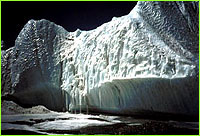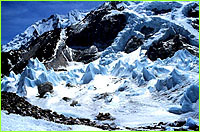 |
 |
 |
 The Anatomy of a Glacier
The Anatomy of a Glacierpart 2 | back to part 1 The ABC's of Glaciology Glacial ice is formed from highly compressed snow. In areas of the world where more snow falls each year than can melt or evaporate, the snow builds up and its structure gradually changes. On the most minute level, a snowflake's delicate hexagonal shape breaks apart under the weight of more snow. The flakes, continually compressed by layers of snow on top of them, are eventually reshaped into rounded grains, with a texture and size similar to coarse sugar. The pockets of air between the grains of snow likewise become smaller and smaller. In time, the compressed snow, known as firn, is transformed to glacial ice. This process, repeated hundreds of times over, is what forms the built-up ice mass of a glacier.  Glaciers and the Water Cycle
Glaciers and the Water CycleAs much as 80 percent of the world's fresh water is locked up inside glaciers. The ice sheets that cover Antarctica and Greenland hold the great majority of this water supply. When summer temperatures bring about the rapid melting of a glacier, the meltwaters that flow downhill release the stored fresh water, replenishing the overall water supply. The glaciers in the Himalaya are not just sliding downhill, they also appear to be melting faster than they can be replenished. Why this is happening is one of the great puzzles of global climate change. The ice is critical for Nepal because it feeds many of the rivers which are Nepal's primary source of drinking and irrigation water. If these ice fields and glaciers disappear, Nepal and India will have to depend on the unreliable monsoon rains for water. Continue Photos: (1) courtesy Roger Bilham. Lost on Everest | High Exposure | Climb | History & Culture | Earth, Wind, & Ice E-mail | Previous Expeditions | Resources | Site Map | Everest Home Editor's Picks | Previous Sites | Join Us/E-mail | TV/Web Schedule About NOVA | Teachers | Site Map | Shop | Jobs | Search | To print PBS Online | NOVA Online | WGBH © | Updated November 2000 |